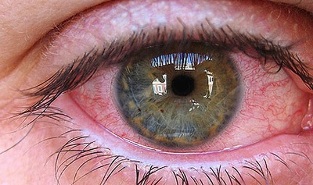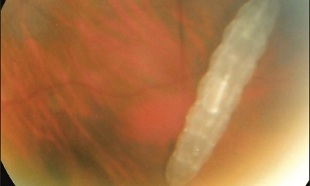
Parasites are round and flat-shaped, more rarely annoying and prickly-headed worms, larval flies and mosquitoes. Once absorbed into the human body, they gradually spread into it, damaging tissues and organs. A large number of them are capable of parasites in the human eye, provoking the development of ophthalmic helminthiasis.
Clinically, this severe pathology is characterized by pain, burning sensation, itching, visual disturbances, lacrimation. Immediately after the diagnosis is made, surgical and (or) conservative treatment is performed.
Diseases caused by parasites in the eyes
More than 50 pathogens of ophthalmohelminthiasis in humans are known. Some penetrate directly through the mucous membranes, damaging the conjunctival or lacrimal ducts. Others infect the eyeball from the inside, moving into it with blood flow from the intestines or liver. Parasites begin to grow actively and reproduce, laying eggs, resulting in partial or complete loss of vision.
Ophthalmohelminthiasis most frequently diagnosed:
- onchocerciasis- helminthiasis caused by parasitism in the human body on Onchocerca nematodes (onchocercias). Its specific symptoms are "turbid" eye cornea;
- ophthalmomyasisis a parasitic disease of the eye and its appendages, which occurs when flies or flies enter. In cases of severe myiasis, retinal detachment or optic nerve atrophy is possible;
- dirofilariasis- helminthiasis that develops when filament nematode larvae attack the eyeballs. The movement of the worm causes a burning sensation, severe pain and itching;
- sparganosisis a human disease of the cestodosis group caused by tapeworm larvae of the genus Spirometra. Infections occur mainly when eating meat from wild animals;
- toxocariasisis a chronic infectious disease provoked by the larvae of toxocara ringworm. The cause of infection is sick animals (usually dogs);
- toxoplasmosisis a chronic parasitic invasion caused by intracellular protozoa (toxoplasma). Their vital activity is accompanied by the constant release of allergens and toxins;
- coenurosisis a chronic disease mainly occurring after infection with worms from the cestodosis group of Taenia multiceps species. A person is infected through contact with dogs;
- cysticercosis- a disease caused by pig tapeworm larvae that can cause decreased vision and blindness;
- gnatostomosis- this disease causes severe pain and often results in death. Worms that cause the disease more often attack the skin, more rarely the central nervous system and eyes;
- echinococcosis of the eyeis a fairly common disease. It is characterized by the formation of parasitic cysts in the orbital zone. Echinococcosis develops due to ingestion of parasitic eggs with food or water.
- eye demodicosis, caused by the activation of mites that live in the sebaceous glands on the eyelashes.
- Trichinosisis a parasitic pathology that develops after the introduction of nichod Trichinella spirali into the human body.

It is not individuals and sexually mature larvae that are harmful to the eyes, but the toxins they release. They cause swelling of the eyelids and redness of the mucous membranes.
Symptoms of eye parasites
Each helminthic invasion has its own symptoms. But they also have many signs of damage to the mucous membranes and deeper ocular structures.
In the early stages of pathological development, special manifestations of conjunctivitis occur:
- redness of the outer skin of the eyeball;
- lacquer increase;
- photophobia;
- swelling of the upper and lower eyelids;
- pain, itching, burning;
- headaches are localized in the temples and back of the head;
- slight increase in local temperature.
Toddlers and weak people experience symptoms of intoxication in general. Temperature rises above subfebrile values (37. 1-38. 0 ° C), appetite decreases due to nausea and vomiting.
Unlike many infections caused by viruses, bacteria and fungi, the helminthic invasion journey is accompanied by signs of damage to other organs. These are moving muscle pains, dry skin, impaired hair growth, and digestive disorders.
How to get rid of parasites from your eyes
Dipter larvae, protozoa, lice and other pathogens of parasitic diseases can quickly destroy eye structures. Therefore, treatment is carried out immediately after diagnosis. When choosing a therapeutic tactic, doctors take into account the type of infectious agent, the severity of the disease and the severity of the symptoms.
If an infected person sees a doctor with advanced helminthic invasion, then conservative treatment often does not work.
Parasitic worms must be removed surgically - by opening and draining the abscess according to generally accepted rules.
Then a long recovery period with the use of anthelmintic medication followed.
People's solution
Although long-term use of powerful modern anthelmintic drugs is often ineffective for the disease. Surgical removal of larvae, eggs and sexually mature individuals is required.
And traditional medicine is not at all energetic when the eyes are exposed to helminths. Both silvery, centaury, and bitter worms are unable to cope with eye aggression.
The use of decoctions and infusions slightly reduces symptoms, so patients delay visits to the doctor. And during this time, the inflammatory and destructive process is increasing and spreading in the eyeballs. They prescribe to release the retina, complete or partial blindness.
Medicine
Various treatment regimens for worm-related ophthalmic diseases have been developed. Individual therapy is performed only by a trained parasitologist. The fact is that after the death of helminths and their decomposition, intraocular toxic allergic reactions can develop. Only an experienced doctor can reduce its effects.
The following drugs are used to kill parasitic worms:
- anti-nematodic;
- anti-cestodial;
- antitrematod;
- broad spectrum drugs.
For external agents, a special solution for rinsing the eyes is used. Antihistamines must be included in the therapeutic regimen, and, if necessary, antibiotics and antimycotics.
Precautions
Infection with myiasis occurs when the mucous membranes of the eyes come in contact with flies, midges, gadflies. Therefore, infectious disease doctors advise to use repellents in the form of aerosols, gels, ointments. Smoke bombs with pesticides scare insects in nature pretty well.
But eggs and larvae of parasitic worms are introduced into the human body especially with food. They are unstable to the effects of temperature - they die when heated and boiled. Also need to wash fruits and vegetables brought from the market and store them well.
Parasitic eye disease cannot be diagnosed and cured independently.
They are often disguised as bacterial, viral, fungal infections. And as they progress, their special features emerge.
A timely visit to the doctor will help save vision, to prevent its loss.



























